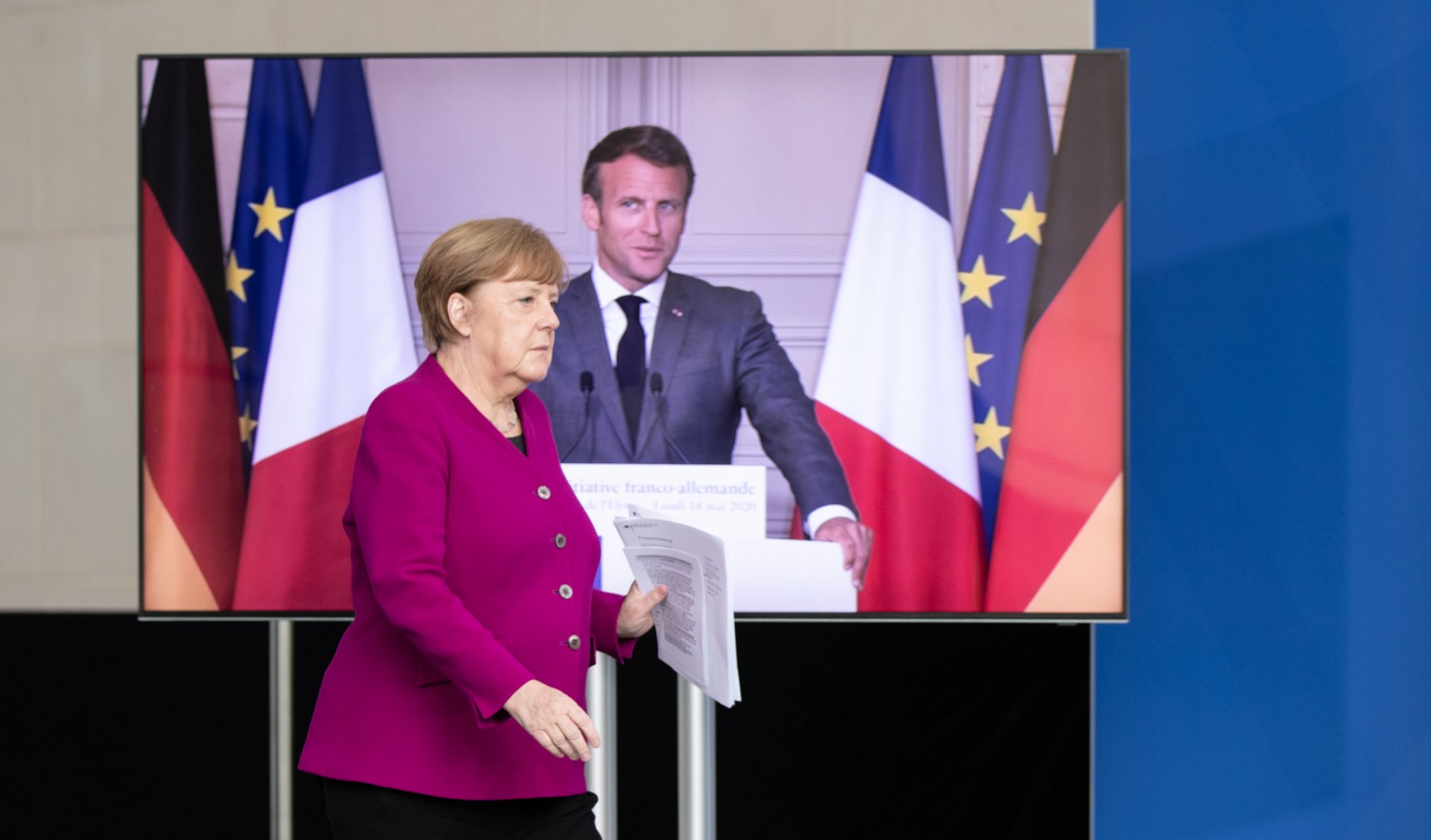On 16 May, French President Emmanuel Macron and German Chancellor Angela Merkel presented their proposal for a “French-German Initiative for the European Recovery from the Coronavirus Crisis”. Their broad and ambitious plan would be part of the EU’s mooted 3-pronged strategy whose other parts – massive loans and allowing countries to hand out state aid – are already largely in place. The “Merkron” suggestion getting the biggest headlines, the borrowing and redistribution of funds through the EU budget is the most critical and, for reasons explained below, also the most controversial.
The announcement differs little from the Commission’s previously sketched out plan. It includes a EUR 500 billion Recovery Fund financed through the EU borrowing on the markets, which would significantly increase the firepower of the EU’s Multiannual Financial Framework. This would require raising the expenditure ceiling of the EU budget to 2% of GNI of Member States (currently at 1%). As for repaying the sums raised, this could either happen long-term through the EU’s annual budget or – a suggestion included in the Franco-German plan – through new revenue streams such as an EU-wide digital tax.
While the Recovery Fund is the most immediately controversial, the initiative’s other three areas could equally trigger some opposition. This includes the call for an EU Health Strategy, likely to spur debate about EU encroachment on national health competences. The Franco-German reference to “speeding up the green and digital transitions” includes a review of state aid rules, which could concern carbon-based industries (e.g. transport, aviation) about “green” conditions. A final point on enhancing industrial resilience and sovereignty suggests using EU competition policy to boost European industries, challenging online platform market power.
Bridging the eurozone divide
The proposed Recovery Fund aims to balance Northern eurozone demands for fiscal alignment with Southern eurozone calls for risk sharing. In brief, it offers grants to Member States that demonstrate “a clear commitment… to follow sound economic policies and an ambitious reform agenda”. Macron described it as “a real change in philosophy”, while Merkel claimed it would mobilise EUR 3 trillion for recovery. It is portrayed as a breakthrough, particularly for Merkel’s backing down from the “loans-only” approach but also for the claim it was run by main protagonists on both sides of the argument, such as Italy and the Netherlands.
This should not be taken to mean that any such consultations resulted in approval. Spain’s Pedro Sánchez and Italy’s Giuseppe Conte called the Franco-German statement “a step in the right direction” – positive, but hardly a full-throated endorsement. Austrian’s Sebastian Kurz repeated a call for loans rather than grants, while a spokesperson for the Netherlands’ Mark Rutte referred to the future Commission proposal as a “starting point”. The day after the Macron-Merkel announcement, Kurz announced that some EU Member States (likely including the Netherlands, Finland, Denmark and possibly Sweden) already intend to present a counter-proposal.
This counter to the Franco-German attempt at EU reform is unsurprising if we recall past efforts at eurozone reform. Macron and Merkel’s Meseberg Declaration in 2018 – which sought to ease the deadlock on EU rules for bank risk reduction by proposing a common eurozone budget – received the same eyebrow-raising reception. The Declaration also bristled EU leaders that viewed their countries as more than levers in a two-state machine, such as when Rutte asserted in a June 2018 “Future of Europe” debate with MEPs that Europe was “more than just France and Germany”.
Where does this leave future discussions?
For all the work put into this proposal, Merkel and Macron may very well have known it was nothing more than a conversation starter. Discussion over spending priorities of the next EU Multiannual Financial Framework will be equally important and inextricably linked, for example, to funding for research, agriculture and regional infrastructure improvements.
The need for unanimous approval also means there will be 27 national governments to deal with as well as national and regional parliaments. How will Eastern European states act when this recovery seems geared towards “core” states like France, Spain and Italy, who stirred up “periphery” state resentment with their support of a “multi-speed Europe”
(e.g. Macron’s “a Europe that advances, sometimes at different speeds”)? Will Poland and Hungary bend so long as they feel their EU subsidies are threatened – though some argue justifiably – by Paris and Berlin?
There will also be pressure not to let COVID-19 distract Brussels from long-desired objectives. Investment in Europe’s future remains top priority for countries like Austria, the Netherlands and the Nordic region, who want to safeguard funding for innovation and digitalisation to bolster Europe’s global competitiveness. Climate- or environmentally-minded MEPs – which must approve the final budget – may also advocate funding for the EU’s long-publicised Green Deal.
A number of these areas are what caused EU budget talks to break down earlier this year. The question now is whether the “too big to fail” theory translates from a post-financial crisis measure to a health one. Leaders will need to sell this argument back home against a backdrop of COVID-19 fatigue and lack of “face time” to work out national differences. This may be what pushes the European Council to hold its June summit live, if only to model the European unity needed for reaching a state of stability and solidarity.

